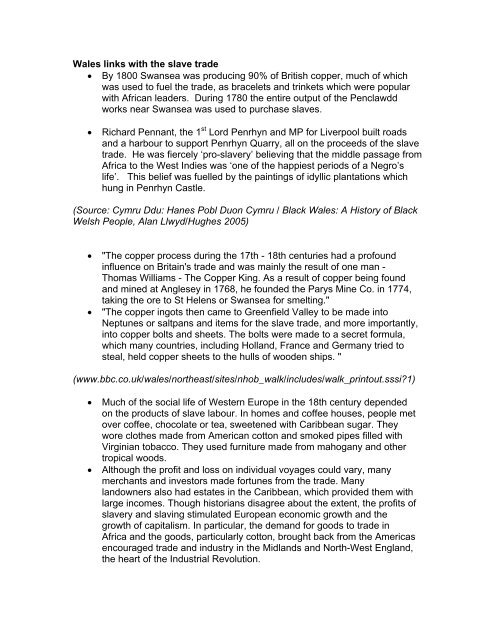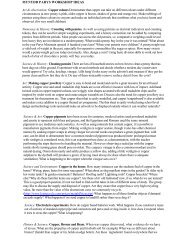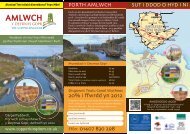Wales links with the slave trade ⢠By 1800 ... - Copper Kingdom
Wales links with the slave trade ⢠By 1800 ... - Copper Kingdom
Wales links with the slave trade ⢠By 1800 ... - Copper Kingdom
You also want an ePaper? Increase the reach of your titles
YUMPU automatically turns print PDFs into web optimized ePapers that Google loves.
<strong>Wales</strong> <strong>links</strong> <strong>with</strong> <strong>the</strong> <strong>slave</strong> <strong>trade</strong><br />
• <strong>By</strong> <strong>1800</strong> Swansea was producing 90% of British copper, much of which<br />
was used to fuel <strong>the</strong> <strong>trade</strong>, as bracelets and trinkets which were popular<br />
<strong>with</strong> African leaders. During 1780 <strong>the</strong> entire output of <strong>the</strong> Penclawdd<br />
works near Swansea was used to purchase <strong>slave</strong>s.<br />
• Richard Pennant, <strong>the</strong> 1 st Lord Penrhyn and MP for Liverpool built roads<br />
and a harbour to support Penrhyn Quarry, all on <strong>the</strong> proceeds of <strong>the</strong> <strong>slave</strong><br />
<strong>trade</strong>. He was fiercely ‘pro-<strong>slave</strong>ry’ believing that <strong>the</strong> middle passage from<br />
Africa to <strong>the</strong> West Indies was ‘one of <strong>the</strong> happiest periods of a Negro’s<br />
life’. This belief was fuelled by <strong>the</strong> paintings of idyllic plantations which<br />
hung in Penrhyn Castle.<br />
(Source: Cymru Ddu: Hanes Pobl Duon Cymru / Black <strong>Wales</strong>: A History of Black<br />
Welsh People, Alan Llwyd/Hughes 2005)<br />
• "The copper process during <strong>the</strong> 17th - 18th centuries had a profound<br />
influence on Britain's <strong>trade</strong> and was mainly <strong>the</strong> result of one man -<br />
Thomas Williams - The <strong>Copper</strong> King. As a result of copper being found<br />
and mined at Anglesey in 1768, he founded <strong>the</strong> Parys Mine Co. in 1774,<br />
taking <strong>the</strong> ore to St Helens or Swansea for smelting."<br />
• "The copper ingots <strong>the</strong>n came to Greenfield Valley to be made into<br />
Neptunes or saltpans and items for <strong>the</strong> <strong>slave</strong> <strong>trade</strong>, and more importantly,<br />
into copper bolts and sheets. The bolts were made to a secret formula,<br />
which many countries, including Holland, France and Germany tried to<br />
steal, held copper sheets to <strong>the</strong> hulls of wooden ships. "<br />
(www.bbc.co.uk/wales/nor<strong>the</strong>ast/sites/nhob_walk/includes/walk_printout.sssi?1)<br />
• Much of <strong>the</strong> social life of Western Europe in <strong>the</strong> 18th century depended<br />
on <strong>the</strong> products of <strong>slave</strong> labour. In homes and coffee houses, people met<br />
over coffee, chocolate or tea, sweetened <strong>with</strong> Caribbean sugar. They<br />
wore clo<strong>the</strong>s made from American cotton and smoked pipes filled <strong>with</strong><br />
Virginian tobacco. They used furniture made from mahogany and o<strong>the</strong>r<br />
tropical woods.<br />
• Although <strong>the</strong> profit and loss on individual voyages could vary, many<br />
merchants and investors made fortunes from <strong>the</strong> <strong>trade</strong>. Many<br />
landowners also had estates in <strong>the</strong> Caribbean, which provided <strong>the</strong>m <strong>with</strong><br />
large incomes. Though historians disagree about <strong>the</strong> extent, <strong>the</strong> profits of<br />
<strong>slave</strong>ry and slaving stimulated European economic growth and <strong>the</strong><br />
growth of capitalism. In particular, <strong>the</strong> demand for goods to <strong>trade</strong> in<br />
Africa and <strong>the</strong> goods, particularly cotton, brought back from <strong>the</strong> Americas<br />
encouraged <strong>trade</strong> and industry in <strong>the</strong> Midlands and North-West England,<br />
<strong>the</strong> heart of <strong>the</strong> Industrial Revolution.
• The income from <strong>slave</strong>ry and <strong>the</strong> <strong>slave</strong> <strong>trade</strong> made many people wealthy.<br />
They built large houses and were able to invest in a wide range of<br />
activities, including banking and industry, as well as supporting charitable<br />
institutions.<br />
• Penrhyn Castle near Bangor in North <strong>Wales</strong> was built for George Hay<br />
Dawkins-Pennant. He was a wealthy Jamaican plantation owner who lived<br />
in Britain. Penrhyn was designed by Thomas Hopper in 1827 as a vast<br />
Neo-Norman castle. It is now owned by <strong>the</strong> National Trust.<br />
• Richard Pennant, later Lord Penrhyn, inherited <strong>the</strong> largest estate in<br />
Jamaica. He devoted much of <strong>the</strong> profits of his plantations to developing<br />
<strong>the</strong> slate quarries of North <strong>Wales</strong>. He was MP for Liverpool 1767-80 and<br />
1784-90 and spoke forcibly against <strong>the</strong> campaign to abolish <strong>the</strong> <strong>slave</strong><br />
<strong>trade</strong>.<br />
• The transatlantic <strong>slave</strong> <strong>trade</strong> generally followed a triangular route. Traders<br />
set out from European ports towards Africa's west coast. There <strong>the</strong>y<br />
bought people in exchange for goods and loaded <strong>the</strong>m into <strong>the</strong> ships. The<br />
voyage itself generally took 6 to 8 weeks. Once in <strong>the</strong> Americas, those<br />
Africans who had survived <strong>the</strong> journey were off-loaded for sale and put to<br />
work as <strong>slave</strong>s. The ships returned to Europe <strong>with</strong> goods such as sugar,<br />
coffee, tobacco, rice and later cotton, which had been produced by <strong>slave</strong><br />
labour.<br />
(http://www.liverpoolmuseums.org.uk/maritime/<strong>slave</strong>ry/eprofits.asp)<br />
Use of copper in <strong>the</strong> African <strong>slave</strong> <strong>trade</strong><br />
Thomas Williams established copper and brass works at Holywell in Flint.<br />
Products made from <strong>the</strong> copper and brass at <strong>the</strong>se factories were used mainly<br />
for <strong>the</strong> African <strong>slave</strong> <strong>trade</strong>. The importance of this <strong>trade</strong> can be seen from<br />
Thomas Williams petition to <strong>the</strong> House of Commons in July 1788.<br />
" A petition by Thomas Williams Esquire, on behalf of himself and his co partners<br />
in <strong>the</strong> manufacture of Brass Battery, and o<strong>the</strong>r <strong>Copper</strong> , Brass and Mixed Goods,<br />
for <strong>the</strong> African Trade at Holywell in <strong>the</strong> county of Flint, Penclawdd in <strong>the</strong> county of<br />
Glamorgan, and Temple Mill in <strong>the</strong> county of Berks...setting forth, that <strong>the</strong><br />
Petitioner and his Co-partners have laid out a capital of £70,000 and upwards to<br />
establish <strong>the</strong>mselves in <strong>the</strong> aforesaid manufactories, which are entirely for <strong>the</strong><br />
African market...and that <strong>the</strong> Petitioner has lately been informed that a Bill is now<br />
depending in <strong>the</strong> House, for <strong>the</strong> purpose of regulating for a limited time, <strong>the</strong><br />
shipping and carrying of <strong>slave</strong>s in British vessels from <strong>the</strong> coast of Africa, which<br />
... will greatly hurt, if not entirely ruin, <strong>the</strong> British <strong>trade</strong> to Africa in <strong>the</strong><br />
manufactories aforesaid, whereby <strong>the</strong> Petitioner and his partners would lose <strong>the</strong><br />
greatest part of <strong>the</strong> aforesaid Capital"<br />
The importance of <strong>the</strong> <strong>slave</strong> <strong>trade</strong> to <strong>the</strong> copper industry had been recognized as<br />
early as 1713 in Bristol. <strong>By</strong> 1726 <strong>the</strong> record of Slave <strong>trade</strong>s in Liverpool showed
that <strong>Copper</strong> was a very important secondary cargo for <strong>the</strong> <strong>slave</strong> <strong>trade</strong>rs. In<br />
1771over 300 tons of brass and 50 tons of copper where export from Britain to<br />
Africa. While in 1776, 220 tons of Brass and 600 tons of copper were exported to<br />
<strong>the</strong> West Indies. <strong>By</strong> <strong>the</strong> 1780's over 1000 tons of copper per year was being sent<br />
to <strong>the</strong> west Indies. At least two vessels "Prince of <strong>Wales</strong>" and "Polly to Bonny"<br />
were in contract to carry <strong>slave</strong>s. <strong>the</strong> ships outward's cargo also included. "<br />
Padlocks and collars for blacks or dogs"<br />
In <strong>the</strong> main manilas or bangles and neptunes and salt evaporation pans were <strong>the</strong><br />
main cargo on <strong>the</strong> outward journey to Africa. For <strong>the</strong> West Indies a large part of<br />
<strong>the</strong> export goods were in form of copper bottoms and plates required for sugar<br />
boiling and rum distillation equipment.<br />
(http://www.amlwchdata.co.uk/parys/<strong>slave</strong>.htm)<br />
Thomas Williams (1737-1802) was a Welsh industrialist. At <strong>the</strong> time of his<br />
death, he was <strong>the</strong> richest man in <strong>Wales</strong>.<br />
In <strong>the</strong> 18th century, <strong>the</strong>re was a significant shortage of food for labouring people,<br />
because supply could not meet demand. Williams, known to his Welsh speaking<br />
workmen as Twm Chwarae Teg ("Tom Fair Play"), once complained to <strong>the</strong><br />
magistrate at Llanidan that <strong>the</strong> villagers on Anglesey raided his fields and stole<br />
<strong>the</strong> turnips intended for his cattle and used <strong>the</strong>m to feed <strong>the</strong>ir families. His<br />
business rival, Mat<strong>the</strong>w Boulton, called Williams <strong>the</strong> "copper king" – "<strong>the</strong><br />
despotick sovereign of <strong>the</strong> copper <strong>trade</strong>". To his friend and agent he said, "Let<br />
me advise you to be extremely cautious in your dealings <strong>with</strong> Williams". He<br />
spoke of Williams as "a perfect tyrant and not over tenacious of his word and will<br />
screw damned hard when he has got anybody in his vice". Of <strong>the</strong> Cornish<br />
producers, Boulton said "<strong>the</strong>y would not have submitted to be kicked and piss’d<br />
on by me as <strong>the</strong>y have been by <strong>the</strong>m" (Williams and his partner Wilkinson.<br />
Williams' tenacity as a lawyer was very evident when acting for <strong>the</strong> Hugheses of<br />
Llysdulas who were in an acrimonious dispute <strong>with</strong> Sir Nicholas Bayly of Plas<br />
Newydd concerning <strong>the</strong> Parys Mountain copper mine. This dispute, which ran for<br />
over nine years, involved <strong>the</strong> interpretation of that very unsatisfactory<br />
testamentary device called a moiety. At one stage <strong>the</strong> dispute involved four years<br />
of expensive litigation in <strong>the</strong> Chancery court <strong>with</strong> <strong>the</strong> Attorney General and <strong>the</strong><br />
Solicitor General acting for opposing sides and was not finally settled until 1778.<br />
In that year Sir Nicholas leased his own copper mine to a London banker John<br />
Dawes (a secret associate of Williams) for 21 years.<br />
Williams emerged from <strong>the</strong> dispute as <strong>the</strong> managing partner <strong>with</strong> <strong>the</strong> Revd<br />
Edward Hughes and John Dawes in <strong>the</strong> Parys Mine Company. This under<br />
Williams control was cheap to run and extremely productive. His great problem<br />
was to obtain an attractive price for <strong>the</strong> copper. He faced a cartel of copper<br />
smelters whose aim was to buy cheap and sell dear. He moved decisively to
establish his own smelting facilities and quickly entered into an agreement <strong>with</strong><br />
John Mackay to establish an industrial complex at Ravenhead near St Helens in<br />
Lancashire. He also established warehousing and copper manufacturing and<br />
finishing facilities, and even a mint – thus creating a vertical organisation.<br />
He also acted quickly to absorb or control o<strong>the</strong>r producers – notably <strong>the</strong> Cornish<br />
mines to produce a complete response to <strong>the</strong> cartel. Although always <strong>the</strong> driving<br />
force, Williams built up and controlled a major commercial organisation and<br />
surrounded himself <strong>with</strong> able staff. The Revd Edward was always a sleeping<br />
partner but younger bro<strong>the</strong>r Michael Hughes was an able manager. O<strong>the</strong>r<br />
partners and staff included The Earl of Uxbridge, Owen Williams, and Thomas<br />
Harrison.<br />
His business organisation was first rate. He developed <strong>the</strong> technique of<br />
establishing his various businesses in separate companies. Thus <strong>the</strong> Parys Mine<br />
Company controlled its own smelting in South <strong>Wales</strong> and Lancashire and copper<br />
manufacture at Holywell. Likewise <strong>the</strong> Mona mine (adjoining Parys) output was<br />
smelted by <strong>the</strong> Stanley Company in both Lancashire and South <strong>Wales</strong>. O<strong>the</strong>r<br />
Companies dealt <strong>with</strong> manufacture at Greenfield near Flint and in <strong>the</strong> Thames<br />
Valley, Chemical Works (vitriol) at Garston Liverpool and still o<strong>the</strong>rs <strong>with</strong><br />
Warehousing and Banking.<br />
Williams had built copper works at Flint and Penclawdd where he made copper<br />
and brass products. Many of <strong>the</strong>se materials were for use in <strong>the</strong> African <strong>slave</strong><br />
<strong>trade</strong>. These copper trinkets etc. were largely exported to Africa for use as<br />
payment for <strong>slave</strong>s, who were <strong>the</strong>n transported to <strong>the</strong> West Indies and sold. The<br />
proceeds were <strong>the</strong>n used to purchase commodities for import into Britain.<br />
Williams claimed to have invested £70,000 in this <strong>trade</strong> and petitioned parliament<br />
in 1788 when a bill was being discussed to prevent British ships from carrying<br />
<strong>slave</strong>s. Williams is said also to have introduced <strong>the</strong> use of copper bolts to fix <strong>the</strong><br />
copper sheeting to naval vessels and it would appear that he sold <strong>the</strong>m to all<br />
sides in <strong>the</strong> naval conflicts!<br />
Thomas Williams born in Llanidan, Anglesey 1737 was clearly a complex<br />
character; tenacious lawyer, remarkable businessman, some would say an<br />
unscrupulous cheat. Certainly he was a decisive man who could and did act<br />
quickly, as on <strong>the</strong> occasion when, <strong>with</strong>out regard for his depositors, he closed <strong>the</strong><br />
doors to pre-empt a run on his Chester and North <strong>Wales</strong> Bank. When he died in<br />
1802, 1,200 people were employed in his Parys and Mona mines, but five years<br />
later <strong>the</strong> number had dropped to 120. This owing partly to <strong>the</strong> collapse of copper<br />
prices, but also to <strong>the</strong> exhaustion (so it was said) of <strong>the</strong> known local copper<br />
deposits – but no doubt largely resulting from <strong>the</strong> death of <strong>the</strong> firm’s great driving<br />
force<br />
(http://en.wikipedia.org/wiki/Thomas_Williams_of_Llanidan)
O<strong>the</strong>r Useful Sites:<br />
Life on a Slave Ship – Hell Below Deck<br />
• http://beatl.barnard.columbia.edu/students/his3487/lembrich/seminar53.ht<br />
ml<br />
• http://www.anti<strong>slave</strong>ry.org/breaking<strong>the</strong>silence/<br />
• http://www.understanding<strong>slave</strong>ry.com/





